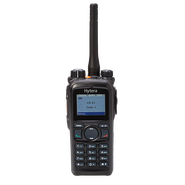Powerco operates and maintains the largest network of electricity lines in New Zealand, with about 335,000 customers connected to its electricity networks. Its footprint is separated into two major regions: the eastern region covers Tauranga, Coromandel, Thames Valley and eastern and southern Waikato, while the western region covers Taranaki, Whanganui, Rangitikei, Manawatu and Wairarapa. In these areas Powerco has its electricity distribution network comprising more than 27,000 kilometres of cables, overhead lines and sub-station assets.
Naturally, such a critical and wide-ranging operation requires reliable communications. Powerco had previously been using an analog radio system that was more than 10 years old. That system covered only about 65% of its electrical network, but the company needed greater than 95%.
After a long appraisal process, Powerco chose to implement a new Hytera DMR Tier III system. Now up and running, it is the largest, industry standard, private digital mobile radio network deployment in New Zealand.
Given the critical nature of Powerco’s business and the need to encompass the very wide geographic spread of its assets, the company spent a great deal of time evaluating potential systems before making a decision on DMR Tier III. Requirements scoping was conducted in the first half of 2015, with RFIs released in Q3 of 2015. Evaluation of the responses and shortlisting also took place in Q3 2015, with proof-of-concept testing for console systems conducted in Q4 2015. RFPs were issued to selected vendors in Q1 2016, with console and DMR vendor evaluation and selection spanning Q1 and Q2 2016. Contracts were signed in Q3 2016.
The key business objectives of the project were to:
• Provide a safer working environment for personnel in the field by establishing a primary communication radio system that has full coverage across the Powerco network;
• Improve the efficiencies of the NOC through improved and integrated communications;
• Provide Powerco with control of the communication network, enabling prioritized access to communications with its field personnel during business-as-usual as well as in emergency and critical situations, such as during storm events.
The company was also seeking to achieve high availability, handover and auto-roaming, as well as the required 95%-plus coverage of its electricity asset base.
According to Powerco’s Network Operations Manager, Phil Marsh, there were a number of qualities and characteristics of DMR Tier III that made it the suitable choice for the new system, including that it has an open-standard, IP-based modular design, an interconnection interface, open protocol SIP, and easily connects to any PABX/ PSTN system.
In addition to those attributes, the Hytera product offered a one-stop solution, IP-connected dispatching client and voice recording system.
The new system has and is supported by:
• A new packet transport network based on Juniper tiered architecture, installed at over 60 comms and substation sites
• Upgraded power and environmental systems at 35 comms sites
• Installation of Hytera DMR Tier III at 35 comms sites
• A new Zetron ACOM console solution at the Network Operations Centre (NOC)
The mobile vehicle radio models are the Hytera MD782G, and the handhelds are the PD782G.
"Powerco staff and contractors have been positive with the new systems, particularly knowing that now they have reliable comms." — Phil Marsh, Network Operations Manager
Ensuring coverage
“In the past, when we used the RT system that had a far smaller reach, we had fault staff needing to drive for half an hour to the top of a hill to get coverage so they could contact the control room,” said Marsh.
“There were places in areas such as the Tararuas, Wairarapa and Rangitikei where they simply didn’t have any comms or cellphone coverage — losing all communication with the control room, which is dangerous, particularly in an emergency.”
But with the new Tier III system, “in the eastern region we are achieving 95%-plus coverage,” said Marsh. “Testing is in progress in the west, but it’s looking promising.”
There are 35 radio sites, but the company has plans to expand the network to achieve greater than 95% coverage, particularly on the fringe of its asset footprint.
Putting it to the test
According to Marsh, “Installations have been smooth and uneventful, except on the odd occasions where high winds have prevented riggers climbing towers to install antennas and feeders. Also, during the winter months, a few sites had track access constraints due to wet weather conditions.”
“Powerco staff and contractors have been positive with the new systems, particularly knowing that now they have reliable comms from most of Powerco’s footprint to the Network Operations Centre (NOC) for day-to-day work instructions, and emergency situations,” added Marsh.
“The feedback during training and subsequent field use has been positive. Powerco has set up ‘DMR Users Forum’ for staff and contractors to resolve any issues and suggest future enhancements.”
One unexpected and welcome benefit has been more efficient operations at the New Plymouth NOC during times of heavy workload.
“During major storms or natural disaster events before this system was introduced, the NOC would activate the ‘Storm Room’ to take overflow telephone and radio calls to prevent the NOC operators being overloaded,” said Marsh. “Since commissioning the DMR and ACOM systems, the operators can handle the telephony and radio traffic much more efficiently during events, and the Storm Room has not needed to be activated.”




